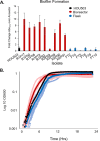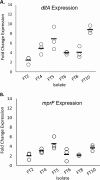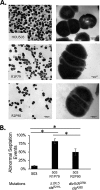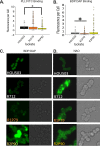Environment Shapes the Accessible Daptomycin Resistance Mechanisms in Enterococcus faecium
- PMID: 31332078
- PMCID: PMC6761497
- DOI: 10.1128/AAC.00790-19
Environment Shapes the Accessible Daptomycin Resistance Mechanisms in Enterococcus faecium
Abstract
Daptomycin binds to bacterial cell membranes and disrupts essential cell envelope processes, leading to cell death. Bacteria respond to daptomycin by altering their cell envelopes to either decrease antibiotic binding to the membrane or by diverting binding away from septal targets. In Enterococcus faecalis, daptomycin resistance is typically coordinated by the three-component cell envelope stress response system, LiaFSR. Here, studying a clinical strain of multidrug-resistant Enterococcus faecium containing alleles associated with activation of the LiaFSR signaling pathway, we found that specific environments selected for different evolutionary trajectories, leading to high-level daptomycin resistance. Planktonic environments favored pathways that increased cell surface charge via yvcRS upregulation of dltABCD and mprF, causing a reduction in daptomycin binding. Alternatively, environments favoring complex structured communities, including biofilms, evolved both diversion and repulsion strategies via divIVA and oatA mutations, respectively. Both environments subsequently converged on cardiolipin synthase (cls) mutations, suggesting the importance of membrane modification across strategies. Our findings indicate that E. faecium can evolve diverse evolutionary trajectories to daptomycin resistance that are shaped by the environment to produce a combination of resistance strategies. The accessibility of multiple and different biochemical pathways simultaneously suggests that the outcome of daptomycin exposure results in a polymorphic population of resistant phenotypes, making E. faecium a recalcitrant nosocomial pathogen.
Keywords: Enterococcus; adaptive resistance; drug resistance evolution.
Copyright © 2019 American Society for Microbiology.
Figures







Similar articles
-
Biochemical characterization of cardiolipin synthase mutations associated with daptomycin resistance in enterococci.Antimicrob Agents Chemother. 2013 Jan;57(1):289-96. doi: 10.1128/AAC.01743-12. Epub 2012 Oct 31. Antimicrob Agents Chemother. 2013. PMID: 23114777 Free PMC article.
-
A Novel Phosphodiesterase of the GdpP Family Modulates Cyclic di-AMP Levels in Response to Cell Membrane Stress in Daptomycin-Resistant Enterococci.Antimicrob Agents Chemother. 2017 Feb 23;61(3):e01422-16. doi: 10.1128/AAC.01422-16. Print 2017 Mar. Antimicrob Agents Chemother. 2017. PMID: 28069645 Free PMC article.
-
Two Mutations Commonly Associated with Daptomycin Resistance in Enterococcus faecium LiaST120A and LiaRW73C Appear To Function Epistatically in LiaFSR Signaling.Biochemistry. 2018 Dec 11;57(49):6797-6805. doi: 10.1021/acs.biochem.8b01072. Epub 2018 Nov 27. Biochemistry. 2018. PMID: 30403130 Free PMC article.
-
DAPTOMYCIN, its membrane-active mechanism vs. that of other antimicrobial peptides.Biochim Biophys Acta Biomembr. 2020 Oct 1;1862(10):183395. doi: 10.1016/j.bbamem.2020.183395. Epub 2020 Jun 9. Biochim Biophys Acta Biomembr. 2020. PMID: 32526177 Review.
-
The Antibiotic Peptide Daptomycin Functions by Reorganizing the Membrane.J Membr Biol. 2021 Feb;254(1):97-108. doi: 10.1007/s00232-021-00175-0. Epub 2021 Feb 23. J Membr Biol. 2021. PMID: 33620544 Review.
Cited by
-
Top-Down Genomic Surveillance Approach To Investigate the Genomic Epidemiology and Antibiotic Resistance Patterns of Enterococcus faecium Detected in Cancer Patients in Arkansas.Microbiol Spectr. 2023 Jun 15;11(3):e0490122. doi: 10.1128/spectrum.04901-22. Epub 2023 Mar 30. Microbiol Spectr. 2023. PMID: 36995227 Free PMC article.
-
Systematic Investigation of Resistance Evolution to Common Antibiotics Reveals Conserved Collateral Responses across Common Human Pathogens.Antimicrob Agents Chemother. 2020 Dec 16;65(1):e01273-20. doi: 10.1128/AAC.01273-20. Print 2020 Dec 16. Antimicrob Agents Chemother. 2020. PMID: 33106260 Free PMC article.
-
Sentinel Surveillance Reveals Emerging Daptomycin-Resistant ST736 Enterococcus faecium and Multiple Mechanisms of Linezolid Resistance in Enterococci in the United States.Front Microbiol. 2022 Feb 1;12:807398. doi: 10.3389/fmicb.2021.807398. eCollection 2021. Front Microbiol. 2022. PMID: 35178041 Free PMC article.
-
Intracellular Experimental Evolution of Francisella tularensis Subsp. holarctica Live Vaccine Strain (LVS) to Antimicrobial Resistance.ACS Infect Dis. 2023 Feb 10;9(2):308-321. doi: 10.1021/acsinfecdis.2c00483. Epub 2023 Jan 20. ACS Infect Dis. 2023. PMID: 36662533 Free PMC article.
-
Mechanistic Insights Into the Differential Efficacy of Daptomycin Plus β-Lactam Combinations Against Daptomycin-Resistant Enterococcus faecium.J Infect Dis. 2020 Oct 1;222(9):1531-1539. doi: 10.1093/infdis/jiaa319. J Infect Dis. 2020. PMID: 32514561 Free PMC article.
References
-
- CDC. 2013. Antibiotic resistance threats in the United States, 2013. Centers for Disease Control and Prevention, Atlanta, GA.
-
- Arias CA, Panesso D, McGrath DM, Qin X, Mojica MF, Miller C, Diaz L, Tran TT, Rincon S, Barbu EM, Reyes J, Roh JH, Lobos E, Sodergren E, Pasqualini R, Arap W, Quinn JP, Shamoo Y, Murray BE, Weinstock GM. 2011. Genetic basis for in vivo daptomycin resistance in enterococci. N Engl J Med 365:892–900. doi:10.1056/NEJMoa1011138. - DOI - PMC - PubMed
Publication types
MeSH terms
Substances
Grants and funding
LinkOut - more resources
Full Text Sources
Medical

